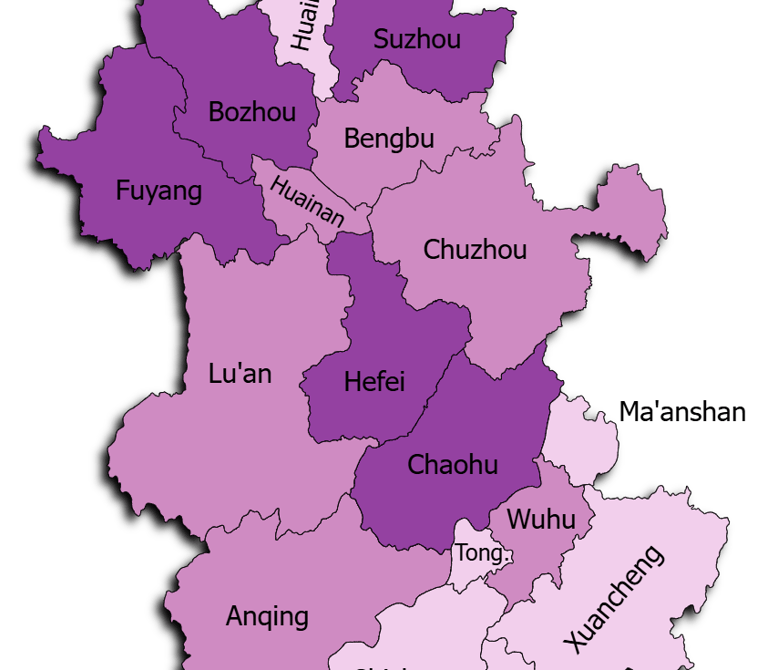Cities in Fujian


Introduction
Hefei lies near the center of Anhui, between the Yangtze River and the Huai River. It has a population of about 9 million. The city is close to Chaohu Lake and the northeastern edge of the Dabie Mountains, combining flat plains with gentle hills. As the provincial capital, Hefei is the political, economic, and research hub of Anhui.


Fuzhou is located in the northeast of Fujian, close to the East China Sea and surrounded by low mountains and rivers. The city has a population of around 8 million. It is about 2 hours from Xiamen by high-speed train. Fuzhou is known for a mix of coastal geography and green hills.
Fuzhou is known as the provincial capital and an important center for administration, culture, and trade. The city has a long history connected to ancient maritime routes and Chinese diaspora migration.
It is also known for traditional lacquerware and tea culture, which continue today. Fuzhou hosts Fuzhou University and other higher education institutions, making it a regional academic hub.
📍 Main places to visit include Three Lanes and Seven Alleys, Drum Mountain (Gushan), West Lake Park, Fujian Museum, Hot Spring Park, and Gu Shan Yongquan Temple.
Fuzhou (福州)
Xiamen (厦门)
Xiamen is in southeastern Fujian along the Taiwan Strait, combining coastline, islands, and hilly inland areas. It has a population of about 5 million. The city is well known for its open view of the sea, and it is accessible by train and ferry to nearby areas.
Xiamen is famous for its role as one of China’s first Special Economic Zones, which helped the city grow into a major center of international business, logistics, and digital industry.
It is also linked to overseas Chinese communities and features strong cultural identity influenced by migration history. The city is home to Xiamen University, one of the most respected universities in China.
📍 Main places to visit include Gulangyu Island, Nanputuo Temple, Xiamen University, Zhongshan Road Pedestrian Street, Jimei School Village, and Huandao Road Coastal Belt.




Quanzhou lies on the southeast coast, facing the Taiwan Strait, with a mix of plains and small mountain ranges. The city has a population of about 8 million. It sits close to Xiamen and is well connected by highways and rail.
Quanzhou is known as one of China’s most important ports in the Song and Yuan dynasties and served as a gateway for maritime trade. It is recognized by UNESCO for its role in the Maritime Silk Road. The city also reflects a blend of religions, languages, and cultural traditions, making it one of Fujian’s most historically significant cities.
📍 Main places to visit include Kaiyuan Temple, West Lake Park, Qingjing Mosque, Quanzhou Maritime Museum, and Licheng Old Town.
Quanzhou (泉州)
Putian (莆田)
Putian is located on the eastern coast of Fujian, between Fuzhou and Quanzhou. The geography includes mountains in the west and seaside areas in the east. The city has a population of about 3 million.
Putian is known for religious heritage, especially the Mazu culture, which is influential among coastal communities in China and Taiwan. It also has a developing industry, including shoes and light manufacturing.
📍 Main places to visit include Meizhou Island, South Shaolin Temple, Putian Museum, and Hanjiang Ancient Street.
Zhangzhou (漳州)
Zhangzhou is located in southern Fujian, near the coast and surrounded by fertile plains and river valleys. The city has a population of around 5 million and sits close to Xiamen.
It is known as an agricultural and trade-related city.
Zhangzhou is known for its fruit farming and tea industry, as well as its connection to early migration toward Southeast Asia.
Some historic towns reflect older regional architecture and cultural influences. The city also develops modern manufacturing.
📍 Main places to visit include Nanjing Tulou, Zhangzhou Ancient City, Dongshan Island, and Yunshuiyao Scenic Area.




Longyan (龙岩)
Longyan is located in western Fujian near the border with Guangdong. It has a population of around 3 million and is surrounded by hills and forested regions.
Longyan is known for its link to Hakka culture and traditional earth-house settlements. It also has mining and energy-related industries.
📍 Main places to visit include Yongding Tulou, Longyan Museum, Historical Hakka Villages, and Meihuashan Nature Reserve.
Nanping (南平)
Nanping is in northern Fujian, close to mountains and forest areas. It has a population of around 3 million. The city is surrounded by natural reserves and river valleys.
Nanping is known for its ecology and agriculture, including tea and bamboo. It also includes the famous Wuyishan area, linked to ancient culture and natural heritage.
📍 Main places to visit include Wuyi Mountains, Nine-Bend River, Wuyi Palace, and Zhouning Waterfall Scenic Area.




Navigation
Main Menu
nathan.china-sphere.com
© 2025. All rights reserved.